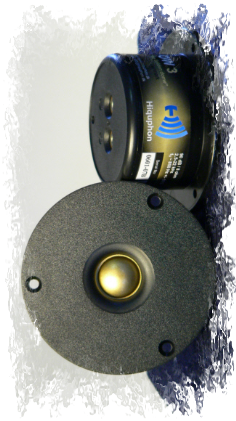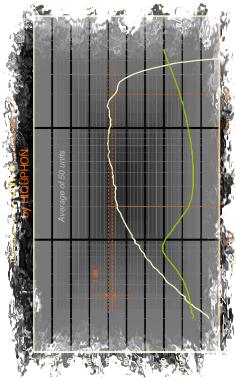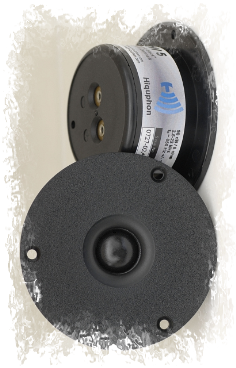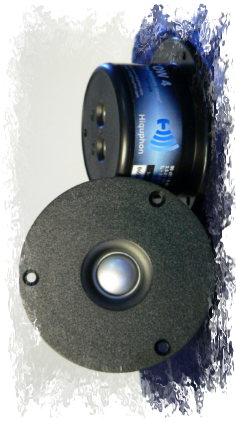Hiquphon 20mm - 3/4 inch soft dome tweeter type OW I, OW II, OW3, OW4, the new OW3 and OW4 and more. Designed and produced in Denmark since 1983.
Main menu:
Products Survey
Products > Overview
Technical description and "how to choose and take the final decision"
All models are 3/4" (20mm) soft dome tweeter with diameter °94 mm, total depth 41,5 mm, closed box of its own, with built-in different chambers for maximum control of resonance phenomenon`s.
The face plate appears with a rough yet smooth, black color finish. The housing is precision moulded ABS. ABS has, compared to metallic housing, an excellent absorbing influence on vibrations traveling from the midrange to the tweeter through the cabinet. ABS, on the other hand, is sufficiently stiff for the important mechanical stability inside the tweeter.
Main groups, types and differences:
We produce different version with different characteristics. As a general rule, we produce three groups, each group offering an optimized standard version, "OWI" and "OWII" and "OW3", "OW4", all among the most excellent 3/4" (20 mm) soft dome tweeters available in the Hi Fi market.
OWI classic
This first group is especially well damped. With soft roll on roll off and sensitivity around 87 dB. Characterized by extremely low distortion and wide frequency area. Controlled drop off far above 20 kHz.
Basic data: 87 dB, 8 ohm.
(you may download an OWI folder here).
OWII classic
This second group is more lightly coated. With very analytic sound reproduction and extremely fast-settling step response and sensitivity around 90 dB.
Controlled drop off just above 20 kHz.
Less linearity compared to OWI, as SPL raise from 2 to approx 5 kHz (87 to 90 dB) and thereafter SPL 90 dB up to 20 kHz.
Basic data: 90 dB, 8 ohm.
(you may download an OWII folder here).
OW3 the golden and OW4 the platinum
This third group is medium coated. With very analytic sound reproduction and very fast step response, sensitivity around 90 dB from 5 - 20 kHz, raising between 2 - 5 kHz from 87dB to 90 dB.
Controlled drop off just above 20 kHz.
Basic data: 90 dB, 8 ohm.
They all share the same acoustical data.
The different numbers refer to dome color:
OW3 is GOLD-like ( you may download an OW3 folder HERE).
OW4 is Platinum-like ( you may download an OW4 folder HERE).
"Oskar: Which type should I choose?",
I have been asked that question by quite many customers during time.
It is a difficult question to answer objectively.
You see, some prefer one design philosophy and some another.
Like with different religion, you may have a special approach to "sound" when it comes to music reproduction and in that matter I can not advise more than try to point out different facts that I have found out during a long life with music and then I hope that "learn by experience" will do the rest.
This, however does not help a customer here and now. So, it is difficult to point out a specific "best choice".
Of course to choose for the OW3 and OW4 you may have a special design philosophy as you may want a special visible impression.
All looks the same in the physical design, except for the dome itself, which is visibly different.
Especially OW3 and OW4 has a very different appearance (Gold or Platinum look-alike).
If you are still doubtful with respect to differences in sonic quality between the tree main types, you should read some more details here below and also I suggest you go to the Testimonial page, where you will find a lot of good advise by reading what impression other customers before you may have experienced.
You can read more here below now or later for more details of general technical nature valid for all types......
The dome (the moving piston):
Cone material has been carefully selected, and coating is applied in several steps, in order to achieve the very best combination of linear SPL response and lowest distortion. Together with linear phase response, crossover design is easily done. Coating the dome is made in several steps developed during many years, and is in fact one of the secrets of the high quality and production equality from batch to batch.
Exponential semi horn:
The special exponential semi horn design, of which the dome diaphragm itself is an important part, features an excellent frequency and phase response.
It goes like this:
As frequency goes higher, only smaller and smaller parts of the dome diaphragm near the voice coil actually moves. So, gradually from being a dome radiator at lower frequencies, the unit turns into a ring radiator at increasing frequency. During this transformation, the dome top itself becomes part of the horn structure at higher frequencies.
This technique results in very advanced acoustical control, offering great response linearity, low distortion and impressive phase linearity.
The magnet system:
The magnet system is driven into a saturated working condition. This means that the highest degree of linearity is achieved.
The magnet is over dimensioned making it impossible for the soft magnetic iron parts (top plate and pole piece) to handle all of the magnetic flux, resulting in the fact that the air gap magnetic characteristics turn in to a close-to-linear phenomenon without hysteresis problems, and with very uniform magnetic distribution in the gap. At the same time influence from variations in magnet size is eliminated.
Mechanics and materials:
Like in the "old-fashioned" turntables, mechanics is essential to the definition and stereo perspective.
Our tweeters are all extremely mechanical solid systems, with heavy housing, well damped reflections, and heavy duty connectors for joining and soldering the leads.
The housing:
The housing is designed to avoid sharp terminals sticking out. That means you can place the unit on any surface without the risk of scratching your expensive polished speaker front while assembling/testing is done. You could even place the unit on your table in your living room without getting into troubles with your wife. The flange is rounded on the rear side of its edge in order to absorb wooden particles in the 4 mm deep hole in the baffle needed to drop the unit in, so that it can be flush with the baffle surface.
Front part and rear part (with the terminals marked + and - for correct polarity) are glued air tight together and can not be split apart. The unit is air tight from behind, so that the dome can not be influenced by any modulation from the woofer in the box.
Terminals:
Inside we use a fiber glass copper plated board with sealed heavy cup terminals, offering heavy soldering joints, to ensure the very best signal path to the voice coil. All connecting joints inside the unit as well as outside provide contact areas much heavier than the connecting wires.
We recommend 2.5 mm2 wires as connection to the crossover or the bipolar terminals if used.
We have seen tweeters with small soldering eyelets buzzing and ringing. When they are soldered, they tend to loosen a bit coursed by the soldering heat. This one is safe. It maintains stiff and non-vibrating under all circumstances. This is important.
The voice coil:
The voice coil is self bonding aluminum wire wound on an selfbonding aluminum form, in a very special way developed by HIQUPHON, changing the wire turns into an extremely compact mechanical unit that will work up till 120 degrees Celsius without damaging, and can handle very high powers in dynamic peaks.
Damping of unwanted vibrations and of traveling waves:
The inner damping is a world of its own!
Damping of the cone suspension absorbs traveling waves from the cone, and prevents from returning into the cone making sum and difference tunes and break-ups (distortion!).
Venting of the chamber underneath the cone suspension is another important detail, and together with the chamber below the cone itself (which is vented to the special cotton wool damped rear chamber) we offer a treble unit which is top tuned and well damped at the same time, in such a sophisticated manner that you probably never would have thought it possible! A lot of effort has been invested here.
Power handling:
Finally we need to use a few words on power handling.
We feel safe to promise a 100 Watt power handling, but don`t really like to be so precise on this value.
The reason is, that we don`t like the term standard music, which you have to define before knowing the part of the total music spectrum handled by the tweeter. But there is no standard music! The music variety is tremendous.
With standard music the tweeter it self must handle only small parts of the higher frequency spectrum coming from a record, CD or what-ever. The energy in this high frequency area is relative low for standard music, but could be many times higher with some kind of special electronic "music". Furthermore, use a tweeter in a box without cross over, and it dies within seconds! Meaning: Power handling is related to the complete box system playing standard music and not to the tweeter.
Our tweeters have been used in well-built speakers capable of handling several hundred watts! (of standard music!).
As a guidance, simply use the tweeter with care and use your brains. Make sure not to expose the unit to defective power amplifiers or to use it with too small amplifiers (clipping).
Use this general rule: If your normal well functioning ears can handle the sound pressure without being stressed, then the tweeter can too! It`s made for human beings.
Use it properly, with a proper crossover, and at least keep direct signals below approximately 2 kHz off the tweeter. Then it will handle all reasonable powers used in a normal domestic living room listened to by normal reasonable persons with normal well functioning ears. Got the picture?
And still, compared to the majority of other 3/4" (19-20 mm) dome tweeters, the power handling is eminent thanks to the very high mechanical finish.
Reliability and production quality:
All these features would be of no value if they were not heard. Therefore, try it for your-self, and be convinced!
Our other customers are convinced. They also benefit from the fact, that the production quality is extremely high. Production procedures are developed during many years, with the special goal to achieve maximum control on uniformity and low distortion.
This is best understood by telling you, that during the last 15 years we have shipped well over 100.000 units, and only a few handful of those have been recognized as defective as a result of our mistakes.
Used in high quality loudspeakers all over the world and under very different circumstances, we have only received less than 100 units in return with faults.
This is less than 1 out of 1000!
We believe this to be a good measure of quality!
Furthermore: Out of these few units returned, several were obviously damaged by the customer them-selves, by overloading from clipping amplifiers and other misuse. The failure rate from faults that can be related to our production therefore is far below 1 out of 1000. We believe that`s pretty good!
Final quality control tests:
All units leaving HIQUPHON are tested at least tree times, two of which are listening tests through-out the entire frequency area.
As a special test of the mechanical assembling, we test the unit through a completely crazy dividing network, giving the unit an awful bad time in the area 100 Hz to 3000 Hz to make sure, that there is no rattling or other mechanical noise at all. (This frequency area is the area in which the resonance`s are most likely to generate undesirable mechanical noise if any mistakes have occurred and consequently will generate higher-order unequal-numbered harmonic distortion).
The production quality is very uniform, and many customers have asked if the units were specially selected or matched. But no! That`s just the way we do it. Precision and commitment combined with the many years of learning and listening.
Yet of course, small differences will occur. Therefore we can offer to supply with every single unit a certificate curve-data sheet for your own further pair-matching, or we can supply the units as matched pairs if necessary (Our OW-series is sold in pairs matched to max 0,5dB within 2-20 kHz). An additional price will be calculated for that kind of service. All units in our OW-series are born as matched pairs, and therefore matching and data sheets are part of their prices.

PS: While working in our factory, we have a nice view over the gardens around Hiquphon.
Now and then we get a visit from deer's who will be grazing around for Ż hour or so.
They seem very trusting and we have great pleasure in watching them.
In the spring/summer/fall we can have our afternoon coffee outdoors and now and then we can watch them grazing within only 20-30 yards. They seem very relaxed with our presence.
I guess this proves that life at Hiquphon is relaxed and without annoying unnecessary noises.





